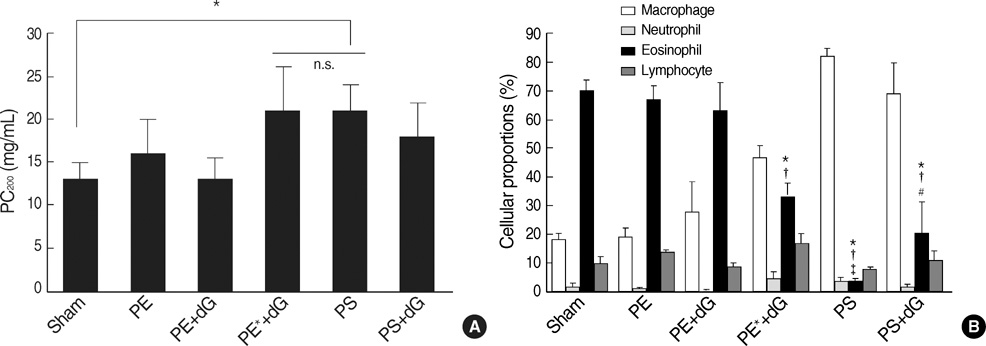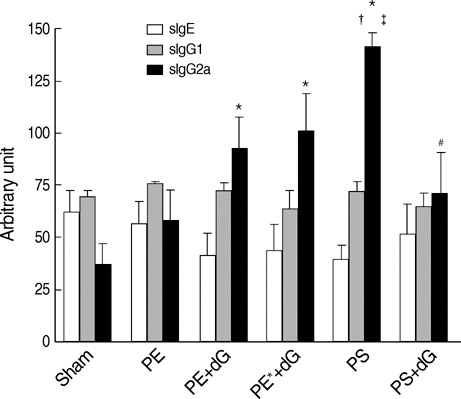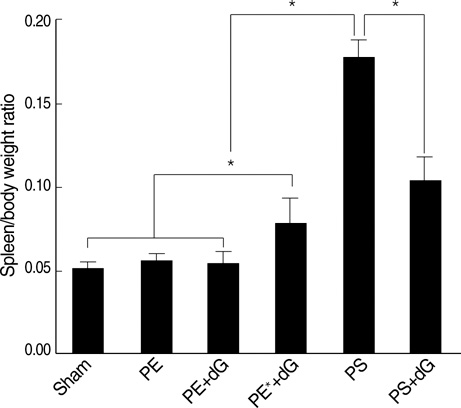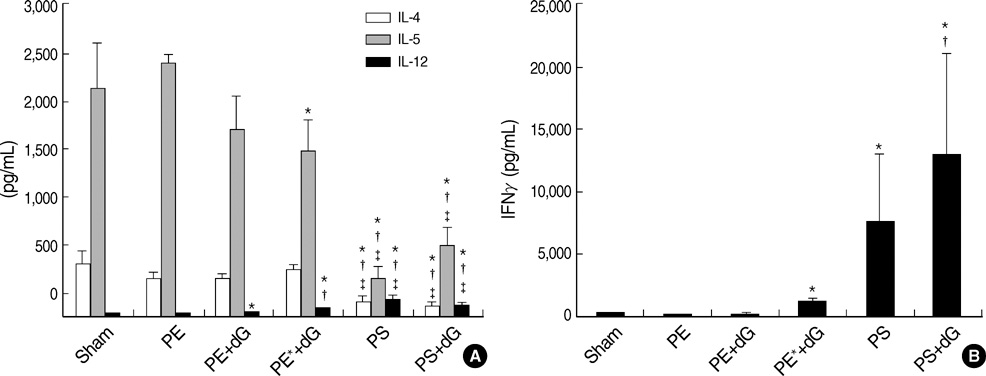J Korean Med Sci.
2009 Oct;24(5):860-866. 10.3346/jkms.2009.24.5.860.
The Effect of CpG-Oligodeoxynucleotides with Different Backbone Structures and 3' Hexameric Deoxyriboguanosine Run Conjugation on the Treatment of Asthma in Mice
- Affiliations
-
- 1Department of Internal Medicine, Seoul National University College of Medicine, Seoul, Korea.
- 2Institute of Allergy and Clinical Immunology, Seoul National University Medical Research Center, Seoul, Korea. shcho@plaza.snu.ac.kr
- 3Department of Internal Medicine, Seoul National University Bundang Hospital, Seongnam, Korea.
- KMID: 1782007
- DOI: http://doi.org/10.3346/jkms.2009.24.5.860
Abstract
- CpG-Oligodeoxynucleotide (ODN) has two backbones. Phosphorothioate backbone (PS) shows a strong immunostimulating effect while phosphodiester (PE) shows little in vivo. 3' hexameric deoxyriboguanosine-run (3' dG6-run) conjugation to PE CpG-ODN has been reported to enhance immunostimulation and to protect against asthma when injected at the time of sensitization in mice. We evaluated the treatment effects of PE and PS CpG-ODN with or without 3' dG6-run on asthma in presensitized mice. BALB/c mice sensitized with ovalbumin and alum were challenged with 1% ovalbumin on three days. CpG-ODNs (100 microgram) or PBS were injected 4 times; 27 hr before challenge and 3 hr before each challenge (CpG-dG6: CpG-ODN with 3' dG6-run, PE*-CpG-dG6: PE-CpG-dG6 with two PS backbones at the 5' terminus). PE-CpG showed no treatment effect. PE-CpG-dG6 only increased ovalbumin-specific IgG2a. PE*-CpG-dG6 increased ovalbumin-specific IgG2a but also reduced BAL fluid eosinophils and airway hyperresponsiveness. PS-CpG increased ovalbumin-specific IgG2a, reduced airway inflammation and airway hyperresponsiveness. PS-CpG-dG6 was less effective than PS-CpG on airway inflammation and airway hyperresponsiveness. In pre-sensitized mice, PE-CpG required not only 3' dG6-run but also the modification of two PS linkages at 5' terminus to inhibit features of asthma. PS-CpG was strong enough to inhibit asthma but PS-CpG-dG6 was less effective.
Keyword
MeSH Terms
-
Animals
Anti-Asthmatic Agents/*therapeutic use
Asthma/*drug therapy/physiopathology
Bronchial Hyperreactivity/drug therapy
Bronchoalveolar Lavage Fluid/immunology
Deoxyguanosine/*analogs & derivatives/*chemistry
Female
Immunoglobulin G/metabolism
Interleukin-12/analysis
Interleukin-4/analysis
Interleukin-5/analysis
Lung/pathology
Mice
Mice, Inbred BALB C
Oligodeoxyribonucleotides/*therapeutic use
Phosphorothioate Oligonucleotides/therapeutic use
Splenomegaly/pathology
Figure
Cited by 1 articles
-
Murine subcutaneous immunotherapy models with beneficial immunological and physiological effects
Yoon-Seok Chang, Yoon-Keun Kim, Sae-Hoon Kim, Heung-Woo Park, Kyung-Up Min, You-Young Kim, Sang-Heon Cho
Asia Pac Allergy. 2013;3(1):50-58. doi: 10.5415/apallergy.2013.3.1.50.
Reference
-
1. Krieg AM, Wagner H. Causing a commotion in the blood: immunotherapy progresses from bacteria to bacterial DNA. Immunol Today. 2000; 21:521–526.
Article2. Vollmer J. Progress in drug development of immunostimulatory CpG oligodeoxynucleotide ligands for TLR9. Expert Opin Biol Ther. 2005; 5:673–682.
Article3. Creticos PS, Schroeder JT, Hamilton RG, Balcer-Whaley SL, Khattignavong AP, Lindblad R, Li H, Coffman R, Seyfert V, Eiden JJ, Broide D. Immune Tolerance Network Group. Immunotherapy with a ragweed-toll-like receptor 9 agonist vaccine for allergic rhinitis. N Engl J Med. 2006; 355:1445–1455.4. Park Y, Chang YS, Lee SW, Cho SY, Kim YK, Min KU, Kim YY, Cho SH, Sung YC. The enhanced effect of a hexameric deoxyriboguanosine run conjugation to CpG oligodeoxynucleotides on protection against allergic asthma. J Allergy Clin Immunol. 2001; 108:570–576.
Article5. Chang YS, Kim YK, Min KU, Kim YY, Seong YC, Cho SH. Conjugation of 3' hexameric deoxyriboguanosine run to phosphodiester CpG oligodeoxynucleotides can inhibit allergen-specific IgE synthesis with less risk of splenomegaly. J Allergy Clin Immunol. 2005; 116:1388–1390.
Article6. Dalpke AH, Zimmermann S, Albrecht I, Heeg K. Phosphodiester CpG oligonucleotides as adjuvants: polyguanosine runs enhance cellular uptake and improve immunostimulative activity of phosphodiester CpG oligonucleotides in vitro and in vivo. Immunology. 2002; 106:102–112.
Article7. Storni T, Ruedl C, Schwarz K, Schwendener RA, Renner WA, BachmannMF . Nonmethylated CG motifs packaged into virus-like particles induce protective cytotoxic T cell responses in the absence of systemic side effects. J Immunol. 2004; 172:1777–1785.
Article8. Chang YS, Kim YK, Kim TB, Kang HR, Kim SS, Bahn JW, Min KU, Kim YY, Cho SH. Airway inflammation and allergen specific IgE production may persist longer than airway hyperresponsiveness in mice. J Korean Med Sci. 2004; 19:69–73.
Article9. Chang YS, Kim YK, Bahn JW, Kim SH, Park HW, Kim TB, Cho SH, Min KU, Kim YY. Comparison of asthma phenotypes using different sensitizing protocols in mice. Korean J Intern Med. 2005; 20:152–158.
Article10. Jeon SG, Lee CG, Oh MH, Chun EY, Gho YS, Cho SH, Kim JH, Min KU, Kim YY, Kim YK, Elias JA. Recombinant basic fibroblast growth factor inhibits the airway hyperresponsiveness, mucus production, and lung inflammation induced by an allergen challenge. J Allergy Clin Immunol. 2007; 119:831–837.
Article11. Lee SW, Song MK, Baek KH, Park Y, Kim JK, Lee CH, Cheong HK, Cheong C, Sung YC. Effects of a hexameric deoxyriboguanosine run conjugation into CpG oligodeoxynucleotides on their immunostimulatory potentials. J Immunol. 2000; 165:3631–3639.
Article12. Bishop JS, Guy-Caffey JK, Ojwang JO, Smith SR, Hogan ME, Cossum PA, Rando RF, Chaudhary N. Intramolecular G-quartet motifs confer nuclease resistance to a potent anti-HIV oligonucleotide. J Biol Chem. 1996; 271:5698–5703.
Article13. Fiscus LC, Van Herpen J, Steeber DA, Tedder TF, Tang ML. L-Selectin is required for the development of airway hyperresponsiveness but not airway inflammation in a murine model of asthma. J Allergy Clin Immunol. 2001; 107:1019–1024.14. Leong KP, Huston DP. Understanding the pathogenesis of allergic asthma using mouse models. Ann Allergy Asthma Immunol. 2001; 87:96–109.
Article15. Cockcroft DW, Davis BE. Mechanisms of airway hyperresponsiveness. J Allergy Clin Immunol. 2006; 118:551–559.
Article16. Kline JN. Eat dirt: CpG DNA and immunomodulation of asthma. Proc Am Thorac Soc. 2007; 4:283–288.
Article17. Ballas ZK, Rasmussen WL, Krieg AM. Induction of NK activity in murine and human cells by CpG motifs in oligodeoxynucleotides and bacterial DNA. J Immunol. 1996; 157:1840–1845.18. Peter M, Bode K, Lipford GB, Eberle F, Heeg K, Dalpke AH. Characterization of suppressive oligodeoxynucleotides that inhibit Toll-like receptor-9 mediated activation of innate immunity. Immunology. 2008; 123:118–128.19. Lenert P, Rasmussen W, Ashman RF, Ballas ZK. Structural characterization of the inhibitory DNA motif for the type A (D)-CpG-induced cytokine secretion and NK-cell lytic activity in mouse spleen cells. DNA Cell Biol. 2003; 22:621–631.
Article20. Lenert P. Inhibitory oligodeoxynucleotides-therapeutic promise for systemic autoimmune diseases? Clin Exp Immunol. 2005; 140:1–10.
- Full Text Links
- Actions
-
Cited
- CITED
-
- Close
- Share
- Similar articles
-
- Effects of CpG-oligodeoxynucleotides in Chronic Inflammation and Remodeling of Airway in a Murine Model of Bronchial Asthma
- Modulation of Eosinophilia and Cytokines of Bronchoalveolar Larvage Fluid(BALF) by CpG Oligodeoxynucleotides(ODN) in a Mouse Model of Established Airway Inflammation
- Effect of CpG Oligodeoxynucleotides on Airways of Mice with Established Airways Inflammation
- Subepithelial Fibrosis-associated Mediators in Mice with Chronic Asthma: Effects of CpG-oligodeoxynucleotides on TGF-beta1 and IL-17
- Effects of Immunostimulatory CpG-Oligodeoxynucleotides of Bronchial Asthma in Rat






